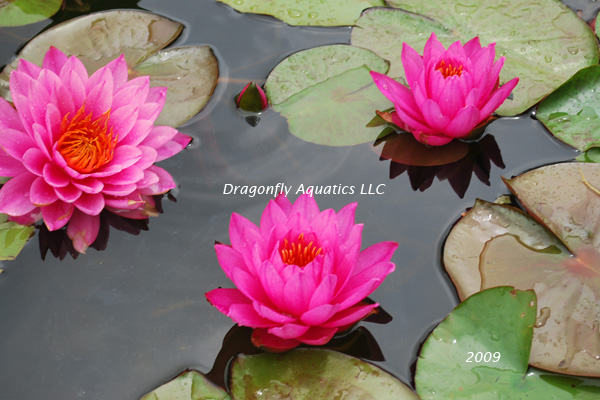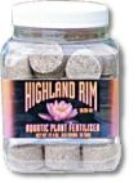 As the weather warms up and we begin to assess what plants we want to add to our ponds this spring, make sure you check out your hardy water lilies to see if they are in need of re-potting. Adding Highland Rim Fertilizer tablets at this time is also a must do. Water lilies need to be fertilized every 4-6 weeks to ensure plenty of flowers this summer.
As the weather warms up and we begin to assess what plants we want to add to our ponds this spring, make sure you check out your hardy water lilies to see if they are in need of re-potting. Adding Highland Rim Fertilizer tablets at this time is also a must do. Water lilies need to be fertilized every 4-6 weeks to ensure plenty of flowers this summer.
Dividing the water lilies and re-potting them in early spring will ensure a better performing water lily this summer. Several lilies in the same pot compete for available nutrients resulting in fewer flowers this summer.
Water lilies need to be planted in at least a 1 gallon planting container for best performance. The medium to large varieties should be potted in a 2 to 5 gallon planting container to reach maximum flowering and growing potential. Don't be fooled by purchasing a potted lily in a 4 inch pot and expect it to flourish in your pond. You will end up paying more for the lily, and will still need to purchase a larger container to re-pot the lily in.
Here it is Spring....the task begins for us water gardeners. Clean the pond, check the water, make sure pumps are working properly, tell the fish "I know you think your hungry, but I cannot feed you until the water temperatures get a little higher..." and then the task of dividing those water lilies to start new ones. It's a lot easier just to purchase new ones, those I don't have, but want.
Dividing and re-potting lilies is not a hard task, but a messy one. It is essential for their health and vitality. When a water lily grows it will eventually grow over and out of its pot. It fills the container with roots and rhizomes, displacing the soil and leaving no room to fertilize it. You can divide it and discard the old roots and rhizomes making space for the lily to renew its strength and keep flowering well.
You will know when it is time to divide a lily when it stops blooming as well and its foliage starts crowding. The leaves become smaller and more sparse. The best time to divide lilies is in the early spring, just before the lily starts to actively grow.
Take the lily out of the pot. Remove the soil by using a spray of water from a garden hose to completely wash away the soil from the rhizome. Generally, a rhizome has a main growing tip. Next select the part or parts from the rhizome that are the nicest. Cut to about three or four inches long and discard any remaining part of the rhizome left. Trim away excess roots and damaged foliage. If you aren't going to re-pot at this time keep the new plant in the shade with damp newspaper covering the plant or submerged in shallow water.
Fill your container with a clay base soil, mound against one side of the container and place the rhizome at a 45 degree angle with the cut edge against the pot and the growing point at the level of where the top of the soil will be. At this point you would want to add a couple fertilizer tablets, one on each side of the plant. You can then add more soil to within a couple of inches from the top of the container. Press the soil firmly in place and add about one inch of small pea gravel to cover the soil but keep it off the growing point of the plant. You can then gently add some water to the container and slowly lower the plant into the pond. If you place it just a few inches under the water for the first few weeks, you will get new growth faster. Then you can place the plant at your proper growing depth which is normally 12 - 20 inches of water over the top of the plant.
Continue to feed your newly planted water lily one fertilizer tablet per gallon of soil monthly and the result will be another great performing lily.
 To grow stronger, healthier and better plants in your pond garden it is essential to use fertilizer that has nitrogen, phosphorus and potassium in it.
To grow stronger, healthier and better plants in your pond garden it is essential to use fertilizer that has nitrogen, phosphorus and potassium in it.
Use a fertilizer that has a lower ratio, such as 6-6-6, which is more often better than using a higher ratio. A higher ratio, such as 20-20-20 can often burn a plant's roots, causing it more harm than good. You should stay away from using organic fertilizers in ponds, such as bone meal or fertilizer that release their compounds gradually. These react differently in pond water than they do in soil. Often a pond owner will use fertilizers that are basically used for perennials, shrubs or trees. These are not made for pond water and you need to pay attention to the amount of ingredients if using these. It is best to use only those fertilizers specially formulated for use in aquatic ponds.
Microbe Lift developed a liquid fertilizer, Bloom & Grown, that is especially formulated for use in ponds. Highland Rim Fertilizer Tablets or similar aquatic pond fertilizer tablets work great. When planting your plants just push them down into the soil in the container and it will feed the plant continuously. It gives the water gardener more control over the amount of fertilizer they use. You would want to feed more often in the summer during the growing season than in the spring and fall.
Customers have told me that their water hyacinths often do not bloom. An idea to give them that extra boost to bloom is take them out of the pond and put them in a separate container and soak them in liquid fertilizer, such as Miracle Grow, for a day or two. Then rinse them and return them to the pond. They soak up the nutrients in the fertilized water and this will help them flower without affecting your pond water. You can do this with other floating plants as well.
If you want more blooms and healthy plants in your water garden add fertilizer. You can receive more enjoyment from the work you put into your pond by caring for your plants.